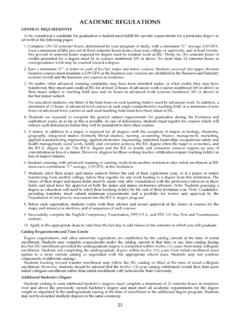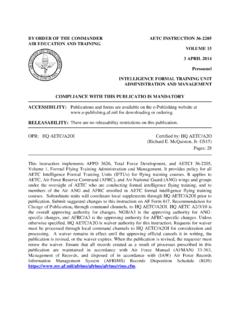Transcription of ADMISSIONS TESTS FOR MBA’S WHO WINS? Jon …
1 ADMISSIONS TESTS FOR MBA'S WHO WINS? Jon Taylor Industrial Psychologist 1. Policy Framework for MBA ADMISSIONS Procedures The goal of admission policies of all public institutions of higher education is spelled out in the preamble of the Higher Education Act 101 of 1997 (as amended). This Act reflects the need for institutions of higher education to strike a balance between a) taking appropriate measures to admit students in order to redress past inequalities, whilst also b) pursuing academic excellence in order to contribute to the advancement of knowledge and scholarship in keeping with international standards of academic quality. This balancing act requires careful thought about how to implement an MBA. ADMISSIONS process that will result in a move away from the educational legacy of apartheid, but at the same time not jeopardize the maintenance of academic standards, since in a globalized world, post graduate business degrees need to be recognized as meeting certain standards of academic excellence.
2 2. ADMISSIONS procedures Institutions offering MBA programmes are empowered by the Higher Education Act to set up ADMISSIONS processes. Minimum entrance criteria of institutions in South Africa offering MBA's are indicated in Table 1. MBA institutions may be oversubscribed by applicants, or may be concerned whether all applicants have the capabilities of passing their MBA programmes. This requires applicants to go through their admission short-listing process. It is not a straight forward task to assess the academic standards of the wide spectrum of applicants from many different disciplines and Universities. This is another important reason for assessing core competencies required to succeed on MBA programmes. A range of MBA ADMISSIONS TESTS are used in SA (see Table 1), reflecting various approaches to ADMISSIONS processes. The most highly rated and sought after MBA's attract the largest numbers of applicants and this is where the ADMISSIONS TESTS usually play a significant role in the allocation of places to applicants.
3 This happens globally for example, the Harvard Business School (HBS), which is a leading provider of MBA education, is heavily over-subscribed by applicants worldwide. They can afford to be extremely selective in who they admit. Applicants have to demonstrate their leadership and academic track record, which the MBA ADMISSIONS Board reviews together with the results of the GMAT. Since MBA programmes are usually fast-paced, intellectually demanding environments in which learning takes place, the HBS aims to shortlist individuals who 1..will thrive on sophisticated ideas and lively discussion . The HBS case-based method of learning, which is widely used in MBA programmes, requires the active participation of prepared students who can assess, analyze, and act upon complex information, often within ambiguous The HBS ADMISSIONS process places emphasis on the demonstrated ability of applicants to master analytical and quantitative concepts.
4 In addition, the right candidates must be eager to share their experiences, support their colleagues, and teach as well as learn from their peers . (HBS Web Page). The above overview of the HBS website provides a good indication of typical competencies needed to succeed as an MBA student o ability to learn in a fast-paced verbal environment where speed is important;. o ability to master analytical and quantitative concepts;. o ability to assess, analyze, and act upon complex information, often within ambiguous contexts;. o demonstrated leadership and academic track record;. o preparedness to share experiences, support colleagues, and teach as well as learn from peers. 3. MBA ADMISSIONS TESTS used in SA. Table 1 below indicates the range of ADMISSIONS TESTS used at the various institutions in South Africa. The predominant TESTS used are Verbal and Numerical Reasoning Ability TESTS (8 institutions); Personality TESTS (5 institutions); the APIL Learning Potential test (3 institutions) and TESTS of academic proficiency (GMAT & National Benchmark Test 5 institutions).
5 TESTS of Numerical and Verbal reasoning These are the most commonly used TESTS for ADMISSIONS purposes in SA, and reflect the high face validity of these tasks in an MBA English comprehension / reasoning and numerical reasoning are likely to be fundamental skills for many of the subjects studied in an MBA and for managerial work. These TESTS can be described as measuring crystallized abilities ( abilities that have developed with repeated exposure and practice in the subject matter at school, home or at work). Some test producers have websites where anyone can log in to practice their verbal and numerical skills. Many bookstores sell materials with exercises designed to improve verbal and numerical reasoning skills. This emphasizes the requirement that applicants should be proficient in these core competencies; so for example, someone with a Fine Arts degree or little exposure to numerical reasoning and calculations is likely to need practice computing percentages and ratios without a calculator to improve their chances of being accepted.
6 There is therefore scope to improve scores on such TESTS given sufficient practice, particularly on the very speeded versions of these TESTS . graduate Management ADMISSIONS Test (GMAT). 2. The graduate Management ADMISSIONS Test is an American designed computerised examination that combines essay and multiple-choice formats. The GMAT score is used to assist in selecting MBA applicants by Wits and UCT. In some cases the GMAT is an alternative to the above mentioned ADMISSIONS TESTS (GIBS, Stellenbosch, NMMU), especially for applicants outside the RSA. The GMAT is not a general knowledge test. Candidates need some specific knowledge of high school mathematics, including algebra and geometry. It is an exam designed to measure the ability to think logically and employ a range of intellectual skills developed from education and/or work exposure. Candidates are assessed in two broad areas: maths and verbal skills. Maths includes problem-solving, basic algebra and geometry.
7 Verbal reasoning includes reading comprehension, critical reasoning and sentence correction. Candidates can prepare for the GMAT by purchasing lesson books or taking preparatory classes. Most GMAT test-takers start preparing about 3 to 6 months before the actual test date. Candidates can take the GMAT exam more than once at around $250 a time to try to improve their scores. This is clearly a proficiency test of crystallized abilities which is likely to be very challenging to those from disadvantaged schools who were not taught maths and do not speak English as their mother tongue. It is not clear how relevant geometry and algebra are to the content of MBA's. National Benchmark test The National Benchmarking Test (NBT) is a South African developed test aimed at helping higher education institutions make sense of the National Senior Certificate, given the questionable validity and reliability of matric results. It is intended to ascertain prospective students' proficiency in language and mathematics, their general academic skills such as interpreting tables and understanding percentages, basic proportions and trends (Yeld, 2009).
8 The NBT is designed to help higher education institutions place prospective students in programmes that meet their educational needs - whether this means they go straight into a first-year programme or into a bridging programme. According to Yeld, this assists institutions develop and adapt their curricula. The introduction of the test, much like the USA's SAT Reasoning Test, follows a worldwide trend towards universities conducting their own ADMISSIONS examinations alongside school-leaving examinations , (Yeld, 2009). The NBT is clearly a scholastic proficiency test, which will largely reflect the quality of the applicant's schooling in terms of their crystallized numerical and verbal abilities. TESTS of Learning Potential 3. In countries in which opportunities have been unfairly distributed, such as happened under apartheid, gaps may exist in individuals' scholastic proficiencies. Poor education, poverty and other types of deprivation constrain the development of skills and knowledge which underlie effective functioning in schools and learning institutions.
9 Many disadvantaged individuals arrive at educational institutions with gaps in their repertoire of skills, particularly numeracy and English literacy. Taylor (1994) argues that the most appropriate instrument to use for selecting applicants for scarce developmental opportunities is not TESTS that assess previously gained knowledge and skills (crystallized abilities), since not all candidates have had equal opportunities to learn the skills measured by such conventional selection TESTS . He suggests that a more appropriate approach would be to use selection tools designed to identify candidates with the greatest potential to learn new skills and knowledge. This new approach aims at assessing the person's capacity to learn new skills in the future. The most effective way to do this is to provide candidates with new cognitively challenging material to process and to learn in a standardized testing situation, and then to objectively assess the degree of learning which takes place.
10 In order not to unfairly favour those from advantaged educational backgrounds, the learning material should be unrelated to the content of any real-life discipline and not be in any language, which is why the subject matter of the test is made up of unique shapes and diagrams. This learning potential instrument is designed to measure cognitive learning potential, using three different paradigms of cognition: o a test of fluid intelligence; in which conceptual reasoning and hypothesis generation is required to analyse shapes in order to identify the odd shape out;. o a dynamic learning potential test that looks at how efficiently new information is processed and learnt over a series of trials, with a structured opportunity to study the material in order to become more proficient in performing the novel task: A curve of learning is generated which reflects the degree of improvement in performance over time;. o A knowledge transfer test and a memory and understanding test of the novel test materials provides further measures of dynamic learning.




